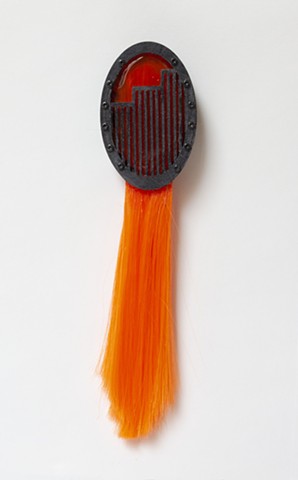Mourning in Orange (Objects for the 21st Century American Victorian)
Mourning in Orange (Objects for the 21st Century American Victorian) are anonymous, stylized memorials to those killed in mass shootings. This series of brooches pulls from the history of Victorian mourning jewelry; precious, individualized memorials that contained a physical token of the lost beloved (often in the form of hair).
A central question behind this work is “What does it look like to mourn the increasing number of dead killed in mass shootings?” The performative nature of mourning jewelry is here transformed into a kind of visual virtue signaling- both acknowledging and critiquing the "rinse and repeat” cycle of media coverage and national grief that inevitably follow every mass shooting in the U.S. Victorian mourning jewelry is unique to the person being mourned and the person doing the mourning, yet the work presented here is by its very nature reproduceable, turning the act of mourning into something common to the point of banality.
Victorian symbols of romanticism and ancient Greece are replaced with contemporary symbols taken from American gun culture. Scarce, valuable materials such as pearls, gold, and human hair are replaced with materials and processes associated with fast fashion such as 3D printed plastic and synthetic hair. Through this shift, the body of the lost loved one and the hand of the artist are replaced by mass produced materials and digital manufacturing. In this way, Mourning in Orange references the real but is disconnected from it: similar to the way that American discourse surrounding mass shootings is woefully abstracted from the actual loss of life.
Those whose lives are consumed by the endless convulsions of gun violence gripping the American body politic suffer a kind of double death- the loss of life, and then the loss of individuality. Victims are ground down into statistics, simplifying and then erasing the horrifying loss that communities suffer in the wake of these tragedies. Mourning in Orange is thus grotesque in its beauty, claiming and then mocking the sincerity of our collective grief.
